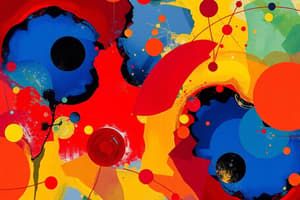Podcast
Questions and Answers
Which form of metabolism rapidly generates ATP using stored creatine phosphate (CrP)?
Which form of metabolism rapidly generates ATP using stored creatine phosphate (CrP)?
- Anaerobic metabolism (correct)
- Glycolysis
- Aerobic metabolism
- Krebs cycle
What is the result of the reaction: CrP + ADP $\rightarrow$ Cr + ATP?
What is the result of the reaction: CrP + ADP $\rightarrow$ Cr + ATP?
- Formation of phosphate
- Formation of creatine
- Formation of ADP
- Formation of ATP (correct)
What temporarily stores energy in the form of electrical energy (ionic gradient) during exercise?
What temporarily stores energy in the form of electrical energy (ionic gradient) during exercise?
- Mitochondria (correct)
- Creatine phosphate
- Muscles
- ATP
Which process utilizes an ionic gradient across the inner mitochondrial membrane to drive the synthesis of ATP?
Which process utilizes an ionic gradient across the inner mitochondrial membrane to drive the synthesis of ATP?
What is the process called when ATP formation is driven by energy released from electrons removed during substrate oxidation?
What is the process called when ATP formation is driven by energy released from electrons removed during substrate oxidation?
What is the primary source of ATP for sustained muscle activity?
What is the primary source of ATP for sustained muscle activity?
Which process quickly exhausts the available ATP during exercise?
Which process quickly exhausts the available ATP during exercise?
What drives numerous energy-requiring activities, including the synthesis of ATP, in mitochondria?
What drives numerous energy-requiring activities, including the synthesis of ATP, in mitochondria?
What is the result of ATP hydrolysis during exercise?
What is the result of ATP hydrolysis during exercise?
What is the order of the molecules (the pathway) in the electron transport chain suggested by the given data from the most reduced to the least reduced molecule?
What is the order of the molecules (the pathway) in the electron transport chain suggested by the given data from the most reduced to the least reduced molecule?
Which type of molecule is ubiquinone in the electron transport chain?
Which type of molecule is ubiquinone in the electron transport chain?
What is the function of iron-sulfur proteins in the electron transport chain?
What is the function of iron-sulfur proteins in the electron transport chain?
How was the specific sequence of carriers in the electron transport chain determined?
How was the specific sequence of carriers in the electron transport chain determined?
Which type of molecules were trapped in reduced form when the inhibitor Ticin was employed?
Which type of molecules were trapped in reduced form when the inhibitor Ticin was employed?
What is the role of molecule X in the electron transport chain based on the given data?
What is the role of molecule X in the electron transport chain based on the given data?
What is the significance of identifying reduced and oxidized components in the presence of different inhibitors in studying the electron transport chain?
What is the significance of identifying reduced and oxidized components in the presence of different inhibitors in studying the electron transport chain?
What do iron-sulfur proteins accept and donate in the electron transport chain?
What do iron-sulfur proteins accept and donate in the electron transport chain?
Which type of molecule is ubiquinone?
Which type of molecule is ubiquinone?
What was used to determine the specific sequence of carriers in the electron transport chain?
What was used to determine the specific sequence of carriers in the electron transport chain?
What is the correct statement about redox reactions?
What is the correct statement about redox reactions?
Which process is involved in oxidation?
Which process is involved in oxidation?
What is true about reduction?
What is true about reduction?
Which is true about strong reducing agents?
Which is true about strong reducing agents?
What is the relationship between NAD+ and NADH?
What is the relationship between NAD+ and NADH?
What does redox potential measure?
What does redox potential measure?
How is standard redox potential at pH 7 indicated?
How is standard redox potential at pH 7 indicated?
What is the role of dehydrogenases?
What is the role of dehydrogenases?
What do NADH and FADH2 do in the electron transport chain?
What do NADH and FADH2 do in the electron transport chain?
Which components are carriers in the electron transport chain?
Which components are carriers in the electron transport chain?
Flashcards are hidden until you start studying
Study Notes
Redox Reactions and Electron Transport Chain
- Redox reactions involve simultaneous reduction and oxidation
- Oxidation involves gain of oxygen or loss of hydrogen/electrons
- Reduction involves loss of oxygen or gain of hydrogen/electrons
- Strong oxidizing agents have high electron affinity; strong reducing agents have weak electron affinity
- NAD+ and NADH are a couple with differing electron numbers
- Redox potential measures species' electron acquisition/donation potential
- Standard redox potential at pH 7 indicated by Eo’
- Dehydrogenases transfer electrons to coenzymes like NAD+ and FAD
- NADH and FADH2 transfer high-energy electrons in electron transport chain
- Flavoproteins, cytochromes, copper atoms, ubiquinone, iron-sulfur proteins are ETC carriers
- Flavoproteins contain FAD/FMN derived from Vit B2
- Cytochromes contain heme prosthetic groups with reversible Fe3+/Fe2+ states
Studying That Suits You
Use AI to generate personalized quizzes and flashcards to suit your learning preferences.




